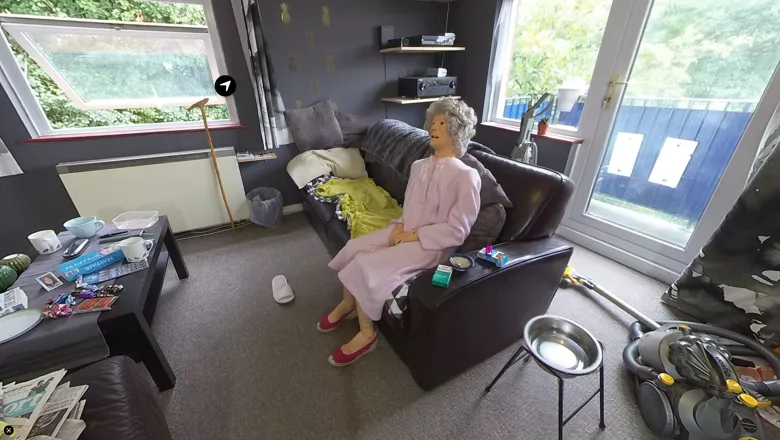11 October 2021
Academics and technicians create a virtual home environment and interprofessional education initiative
Kate Bazin, Lecturer in Physiotherapy Education
Resource that will be delivered to over 900 students in the 2021-22 academic year.

An interprofessional group of King’s College London staff have been collaborating on an exciting new Interprofessional Education (IPE) initiative since October 2019. IPE Simulated Home Environment (SHE) centres around the advent of a new, simulated, virtual home environment that enables students to remotely navigate around and assess a patient’s living conditions, simulating an in-person home visit in the community. A pilot was carried out in March 2021 and evaluated with support Faculty of Life Sciences & Medicine's Teaching Innovation Fund. SHE will be delivered to all second year Dietetics, Physiotherapy, Medicine, Adult Nursing, and all third year Pharmacy students in April 2022.
How did this come about and why is this community-based IPE opportunity so important?
Paul Dudley, Technical Manager at the Chantler Simulation & Interactive Learning Centre, created a virtual home environment using a specialist 360° camera. A virtual space was created which could be explored in 2D or 3D, via screen or virtual reality headset respectively. An interprofessional group met in October 2019 to discuss how this resource could be best utilised for IPE.
In addition to the challenges of physical space and timetabling restrictions, the group were also aware that healthcare students’ experience of working in the community has been impacted by limited community placement capacity. The Covid-19 pandemic further impacted the capacity for community healthcare teams to offer pre-registration healthcare student placements. This has meant that students may have very limited experience of community-based working prior to graduation. Consequently, this may further influence new graduate confidence and understanding of the complexities of supporting patients in the community and effective discharge of patients from secondary care.
To enable community-based learning remotely during the pandemic, the project team adapted the SHE to be delivered in 2D instead of 3D utilising the headsets in-person on campus.
What was involved in the pilot?
The initiative involved developing a case study of a fictional patient who presented with risks on assessment related to medication use and storage, falls, and self-neglect. The patient’s care records were created using the Southwark Community out-patient, community, and initial assessment referral forms as a template to increase fidelity.
Twenty students took part in the SHE pilot. Students were allocated three hours and all tasks were student-led, with clear instructions provided within a designated IPE KEATs page. In the first hour, students reviewed the patient referral information and the home environment individually. Next, the students met as a group on Teams to complete a holistic risk assessment and an action plan on the assessment form. Finally, following the submission of their completed assessment form, students had access to a video exemplar of a Multidisciplinary Team discussion about the patient’s assessment, which they could watch as a group or independently.
Following the pilot, the session was evaluated through completion of a questionnaire. Students were also invited to take part in a focus group about the experience.
What were the main results of the evaluation?
Students felt that the online resources, including navigating through the patient’s home environment, were easy to use. Students described how the simulated home environment felt real and authentic. Those who had previous community placement experience said that participating made them feel as though they were back on placement in the community due to the simulation’s realism. Other students felt that seeing the patient’s home environment allowed them to better appreciate the full picture of how patients live. Participants reported that the task helped them to shift from thinking ‘clinically’ or ‘academically’ to considering the patient holistically. This led the students to consider more practical, patient-centred treatment plans and solutions.
Participants also emphasised the benefits of having an interprofessional peer group for the activity itself. They enjoyed working with people from other disciplines as this provided an opportunity to highlight their skills and learn about each other’s unique knowledge, specialty, and contributions to patient care. Students recognised that although different disciplines had different focuses, they shared common central goals.
Students felt there were advantages to completing the simulation online rather than in-person. They noted that they were free to explore the patient’s home together safely and without worrying about being intrusive.
What’s next?
This pilot study has provided good rationale for rolling out the initiative to full cohorts of healthcare students (994 students) during the 2021-22 academic year, with scope for further evaluation at a larger scale. This research may also inform similar initiatives to develop skills within existing community teams and qualified staff.
The Team:
Kate Bazin (project lead), Chloe Apps, Benjamin Buckley, Michael Detyna, Paul Dudley, Prof Rick Iedema, Dr Liza Kirtchuk, Annemarie Knight, Dr Mary Raleigh, Natalie Sanford, Rita Shah.




